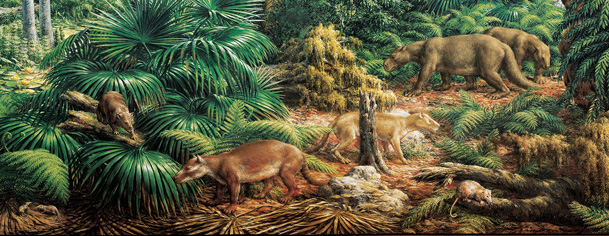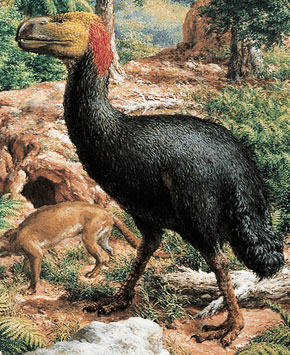Paleocene
Paleocene Epoch (65.5 – 55.8 MYA)

An extract from Rudolph F. Zallinger’s mural “The Age of Mammals,” showing reconstructions of Paleocene mammals. From left to right these are Palaeoryctes, a protoeutherian mammal; the condylarth ungulates Loxolophus and Tetraclaenodon; the pantodont herbivores Pantolambda and Barylambda; and the marsupial Thylacodon. © Yale University
The Paleocene epoch immediately followed the extinction of the dinosaurs. The Earth's climate was warmer than today, but cooler and drier than the epochs immediately preceding and following it. Europe and North America were connected, as were Asia and North America at times. South America was an island continent, widely separated from North America. Africa, South America, Antarctica and Australia, which had once formed a giant supercontinent called Gondwanaland were pulling away from each other.
During the Paleocene many modern plant species appeared such as cacti and palm trees and the relatively warm temperatures worldwide gave rise to thick forests around the globe. Mammals became more diverse during the Paleocene and many evolved larger body size, adopting ecological roles similar to the now-extinct dinosaurs. These early mammals are only distantly related to living species and they retained very primitive teeth and skeletons.
The earliest hoofed ungulates, including the condylarths, which were closely-related to the ancestors of perissodactyls, appeared during Paleocene. Other examples of Paleocene animals include the rodent-like multituberculates, and giant flightless predatory birds such as Gastornis.
One of the best places to find Paleocene fossils is the Bighorn Basin in Wyoming, where mammal fossils have been collected in abundance. The sediments of the Bighorn basin were formed by erosion of uplifting mountains and the sediments are stacked in layers that record many millions of years through the Paleocene and into the next epoch, the Eocene.
Eocene >

